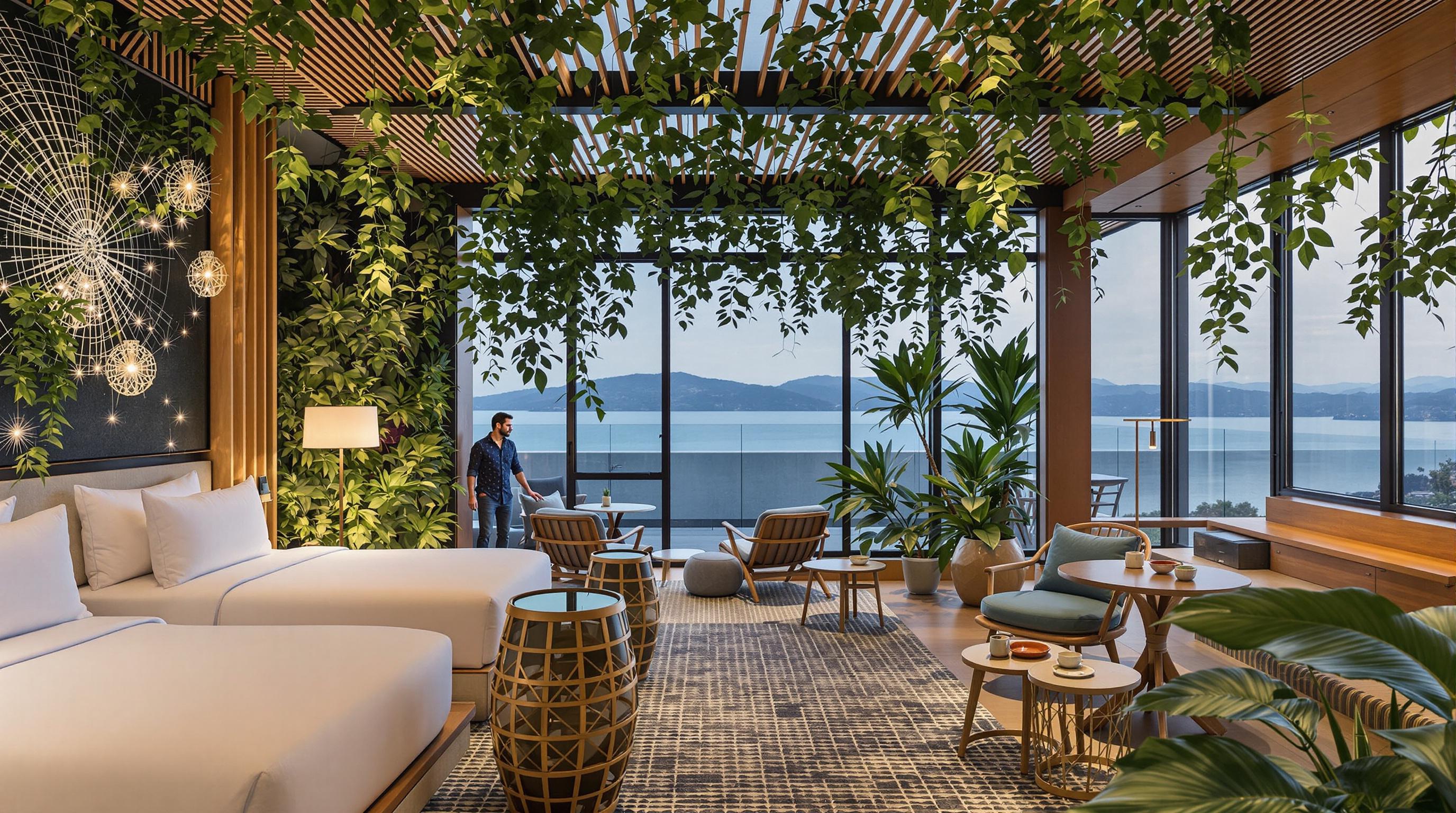Related Articles
- Culinary Cartography: The Unexpected Foods Shaping Local Identity in Urban Landscapes
- Flavors of the Forgotten: Rediscovering Culinary Traditions in the Shadows of Modern Food Trends
- Palate Pilgrimage: The Unlikely Fusion of Ancient Rituals and Modern Local Fare
- Ecosystem Engineers: Celebrating the Role of Nature-Based Solutions in Transforming Eco-Travel Experiences
- Ghost Towns and Green Trails: Unearthing Sustainable Journeys Through Forgotten Landscapes
- Hidden Footprints: Decoding the Carbon Footprint of Digital Nomadism in Edging Towards Sustainable Getaways
9 Unexpected Benefits: How Biophilic Design is Transforming Hospitality to Promote Sustainable Tourism and Guest Well-being
9 Unexpected Benefits: How Biophilic Design is Transforming Hospitality to Promote Sustainable Tourism and Guest Well-being
9 Unexpected Benefits: How Biophilic Design is Transforming Hospitality to Promote Sustainable Tourism and Guest Well-being
Understanding Biophilic Design
Biophilic design is an innovative approach that integrates natural elements into architectural and interior design. This concept promotes a connection to nature, which fosters an environment conducive to relaxation and rejuvenation. The philosophy is rooted in the belief that human beings have an innate desire to connect with nature, a concept supported by the biophilia hypothesis introduced by Edward O. Wilson in the 1980s.
In the hospitality sector, biophilic design encompasses elements like natural light, indoor plants, and water features, allowing guests to experience a sense of tranquility. This approach goes beyond mere aesthetics; it contributes to a sustainable framework that actively encourages environmentally friendly practices. By employing biophilic design, hotels are not only enhancing guest experiences but also taking steps toward sustainability.
The rise of biophilic design reflects a broader trend in consumer preferences, with travelers increasingly valuing wellness and sustainability. According to a recent study by the Global Wellness Institute, the wellness tourism market is projected to reach $1 trillion by 2025. This indicates a strong opportunity for hospitality businesses to capitalize on these trends through thoughtful, nature-inspired design.
1. Enhanced Guest Well-being
One of the most significant benefits of biophilic design is its positive impact on guest well-being. Studies have shown that exposure to natural environments can lower stress levels, enhance mood, and boost overall satisfaction. Incorporating elements like green walls, natural materials, and spacious layouts cultivates a calming atmosphere conducive to rest.
Hotels incorporating biophilic elements have reported increased guest satisfaction and loyalty. For instance, a study published in the journal "Environmental Psychology" found that guests in biophilic-designed hotels experienced a greater sense of relaxation, leading to longer stays and positive reviews. This not only boosts the hotel’s reputation but also encourages repeat business.
Moreover, providing a serene atmosphere through biophilic design allows for enhanced wellness offerings within hospitality spaces, from yoga classes to meditation rooms, further capitalizing on guests' growing interest in holistic health options.
2. Promoting Sustainability
Biophilic design significantly contributes to sustainable tourism by promoting ecological responsibility. Incorporating sustainable materials, energy-efficient systems, and water-wise landscaping demonstrates a commitment to reducing a hotel’s environmental footprint. As sustainability becomes an increasingly important factor for travelers, hotels adopting these practices are more likely to attract eco-conscious guests.
Furthermore, biophilic design typically includes elements such as living roofs or walls that enhance energy efficiency by providing natural insulation. Utilizing renewable resources and creating habitats for local wildlife can also forge essential connections between the hospitality sector and its surrounding environment, enhancing local biodiversity.
By prioritizing sustainability through biophilic design, hotels not only comply with environmental regulations but also contribute to the larger movement toward responsible tourism. This progressive attitude can further resonate with guests who share similar values, creating a loyal customer base.
3. Connection to Local Culture
Incorporating biophilic design allows hotels to connect guests with local traditions, materials, and landscapes. By embedding local flora and fauna into the architecture and decor, properties can create an authentic experience that reflects their geographical location. Tourists often seek out unique experiences that resonate with local culture, and biophilic design facilitates this connection.
For example, properties in coastal regions might incorporate sea-inspired decor elements, while mountain lodges may utilize wood and stone indigenous to the area. This immersion not only enriches the guest's experience but also supports the local economy by utilizing local artisans and materials.
Moreover, when guests feel a deeper connection to the place they are visiting, they are more likely to respect and protect that environment, enhancing the sustainability of tourism in those locations. This fosters a mutually beneficial relationship between visitors and the communities they engage with.
4. Improved Air Quality
One of the key components of biophilic design is the integration of indoor plants and natural ventilation systems. These elements help improve indoor air quality, which has direct implications for guest health and comfort. Plants act as natural air purifiers, filtering out toxins and releasing oxygen, thereby creating a healthier indoor environment.
Research indicates that improved air quality can lead to increased concentration, reduced fatigue, and better overall physical health. For hotels, this translates to higher guest satisfaction and lower instances of complaints related to discomfort. Higher indoor air quality has also been correlated with fewer sick days for staff, contributing to a more efficient work environment.
Travelers are increasingly aware of the impact of their environment on their health and well-being. Hotels that promote enhanced air quality through biophilic design elements can hold a competitive advantage in differentiating themselves to health-conscious consumers.
5. Economic Benefits
Biophilic design can translate into significant economic benefits for hotels. Investments in biophilic elements often yield a high return on investment (ROI). Guests are willing to pay a premium for accommodations that provide aesthetically pleasing, health-promoting environments. This is particularly true for properties that focus on wellness tourism.
By enhancing guest experiences and attracting a diversified clientele, hotels can increase occupancy rates and daily rates (ADR). A study from "Harvard Business Review" noted that businesses focusing on biophilic design reported increases in both customer satisfaction and revenue.
Moreover, through the adoption of sustainable practices tied to biophilic design, hotels can reduce operational costs over time. Energy-efficient systems and reduced resource consumption will ultimately generate cost savings, contributing to a more sustainable business model.
6. Positive Brand Image
Incorporating biophilic design into hospitality settings aids in fostering a positive brand image. By aligning business practices with principles of sustainability and wellness, hotels can position themselves as leaders in the industry. Guests are more likely to recommend and return to hotels that demonstrate social responsibility and promote eco-friendly solutions.
Brands that utilize biophilic design often leverage this aspect in their marketing strategies. With travelers increasingly seeking meaningful experiences, showcasing a commitment to nature and local culture can differentiate a brand in a crowded marketplace.
This positive brand image can also draw the attention of investors and partners who value sustainability initiatives. According to a report from the World Economic Forum, sustainable investments are on the rise and hotels with a biophilic focus will likely benefit from this growing trend.
7. Enhanced Aesthetic Appeal
Biophilic design fundamentally revolves around integrating natural elements, which inherently enhances the aesthetic appeal of hospitality spaces. Elements like natural light, greenery, and organic materials create inviting atmospheres that appeal to all the senses. The visual allure of a well-designed space can greatly influence a guest's perception and overall experience.
Studies demonstrate that guests respond positively to properties that embrace biophilic elements, often leading to increased engagement and extended visitation periods. A 2020 study from "Architectural Research" highlights that hotels utilizing nature-inspired designs witnessed a notable drop in guest turnover, as comfort creates a desire to stay longer.
As hospitality companies place a greater emphasis on design, biophilic principles will likely play an increasingly prominent role in fashioning not only guest accommodations but also shared spaces such as lounges, cafes, and recreation areas, creating a cohesive, nature-infused environment.
8. Increased Guest Engagement
Biophilic design promotes increased engagement between guests and their environment. Through sensory stimulation—sights, sounds, and smells of nature—guests are encouraged to explore both the interiors and exteriors of hospitality spaces. This greater interaction can lead to more meaningful experiences, enhancing guest satisfaction.
Hotels designing spaces that facilitate social interactions, such as communal gardens or rooftop terraces, inspire guests to connect not only with nature but also with fellow travelers. This community atmosphere can create lasting memories and foster connections that extend beyond the hotel.
Interactive biophilic features, including workshops on local flora, guided nature walks, and educational programs about sustainability, further enrich the guest experience. Hotels that stimulate guest engagement through biophilic design ultimately evolve into dynamic spaces that encourage exploration and interaction.
9. Future-Proofing Hospitality
As the hospitality industry continues to evolve, hotels must adapt to changing consumer expectations and environmental regulations. Biophilic design is not just a trend; it represents a sustainable approach to future-proofing hospitality. By integrating natural elements and practices today, hotels can ensure their long-term relevance and competitiveness.
Investing in biophilic design prepares businesses for future challenges related to sustainability and guest well-being. As consumer preferences shift toward sustainability and wellness, hotels embracing these principles will likely outperform their competitors who lag behind in adopting environmentally friendly practices.
In conclusion, the unexpected benefits of biophilic design extend far beyond mere aesthetics; they encompass enhanced guest well-being, sustainability, authentic connections to local culture, and significant economic impacts. As the hospitality industry navigates an increasingly conscious consumer base, biophilic design will play a pivotal role in shaping the future of travel.




